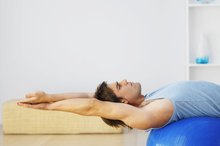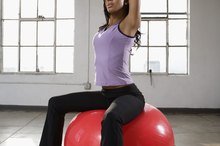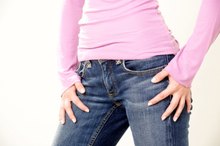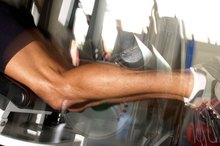Tennis Ball Exercises to Relieve Tight Paraspinals
The paraspinal muscles are important for maintaining correct posture and spinal curvature. They run parallel to your spine and attach to your vertebrae. These muscles work with the obliques on the sides of your abdominals to hold your spine upright.
Tight paraspinal muscles can cause back pain, and you might develop small muscle cramps there called trigger points, which will be tender to the touch. Trigger tennis ball exercises help relieve tension.
1. Trigger Point
A tennis ball applies pressure to your body like a massage but without tiring your fingers. It can also allow you to get to places you cannot otherwise reach, like the paraspinals. Trigger point tennis ball exercises release tension from knots or trigger points by trapping the ball between your back and hard surfaces.
HOW TO DO IT: Once you find a spot that hurts, relax as the ball presses against the muscles until you feel a release. Pressure should be strong but not irritating. Exercises lessen pain but only temporarily, according to an article on the Massage Glasglow website.
- A tennis ball applies pressure to your body like a massage but without tiring your fingers.
- HOW TO DO IT: Once you find a spot that hurts, relax as the ball presses against the muscles until you feel a release.
2. Wall Tennis Ball
Tennis Balls to Reduce Neck Tension
Learn More
An easy exercise to relieve trigger points is the standing compression against a wall. This exercise allows you to control the amount of compression against your back by adjusting your distance from the wall, according to "Trigger Point Therapy for Low Back Pain" by Sharon Sauer and Mary Biancalana 1.
HOW TO DO IT: To perform this exercise, stand with your back near a wall, place a tennis ball in a knee-high sock and hang the ball over your shoulder. Lean against the ball to apply pressure to your upper back and then slowly lower the ball down your spine, stopping at each painful point.
- An easy exercise to relieve trigger points is the standing compression against a wall.
- Lean against the ball to apply pressure to your upper back and then slowly lower the ball down your spine, stopping at each painful point.
3. Lying Tennis Ball
The floor works just like a wall as a hard surface to trap the tennis ball. The difference is that lying on a ball gets a deeper compression because gravity pulls you down, but it is also harder to control the pressure.
HOW TO DO IT: Lie on your back with your knees bent and feet on the floor. Begin with the tennis ball under your lower back and walk your feet forward to roll the ball up to your neck. Use your arms on the floor at your sides for balance or support your head with your hands.
- The floor works just like a wall as a hard surface to trap the tennis ball.
- Begin with the tennis ball under your lower back and walk your feet forward to roll the ball up to your neck.
4. Driving
Exercise Ball for Sciatica Relief
Learn More
Keeping your back in a fixed position on long drives in your car can increase tension in already tight muscles.
HOW TO DO IT: Place a tennis ball between your back and your seat to relieve tension with compression. Have a passenger move the ball up and down your spine to hit the same points on your back.
This technique is even better when you are a passenger so you can move the ball yourself. If no one is riding with you, do not try to use the tennis ball while the car is moving. Pull over to a rest stop or parking lot.
- Keeping your back in a fixed position on long drives in your car can increase tension in already tight muscles.
- Have a passenger move the ball up and down your spine to hit the same points on your back.
Related Articles
References
- Trigger Point Therapy for Low Back Pain; Sharon Sauer and Mary Biancalana; 2009
- Crossfit Journal Articles: Trigger Point Massage (pdf)
- Spine-Health: Back Exercises and Abdominal Exercise Recommendations
- Sekendiz B, Cuğ M, Korkusuz F. Effects of Swiss-ball core strength training on strength, endurance, flexibility, and balance in sedentary women. J Strength Cond Res. 2010;24(11):3032-40. doi:10.1519/JSC.0b013e3181d82e70
- Yu W, Cha S, Seo S. The effect of ball exercise on the balance ability of young adults. J Phys Ther Sci. 2017;29(12):2087-2089. doi:10.1589/jpts.29.2087
Writer Bio
Sarka-Jonae Miller has been a freelance writer and editor since 2003. She was a personal trainer for four years with certifications from AFAA and NASM. Miller also worked at 24 Hour Fitness, LA Fitness and as a mobile trainer. Her career in the fitness industry begin in 2000 as a martial arts, yoga and group exercise instructor. She graduated cum laude from Syracuse University.









